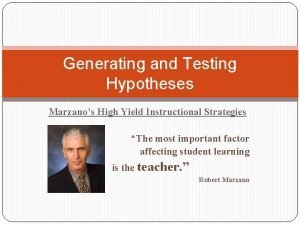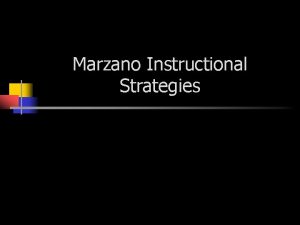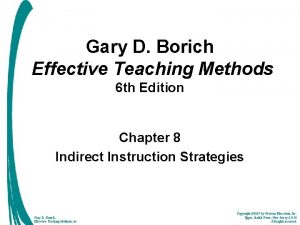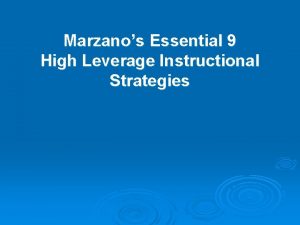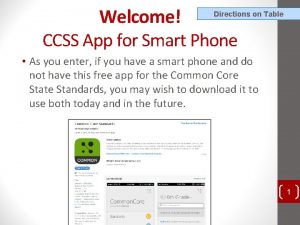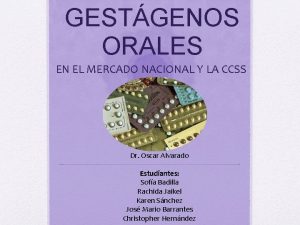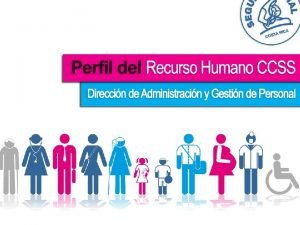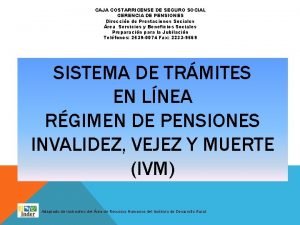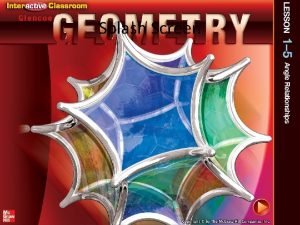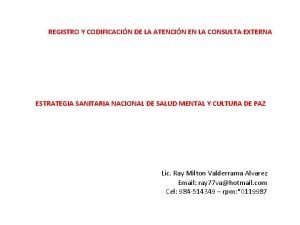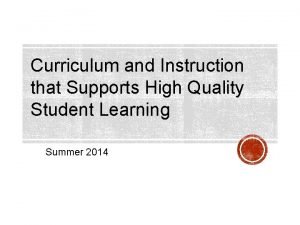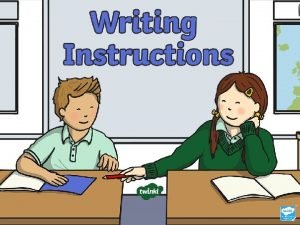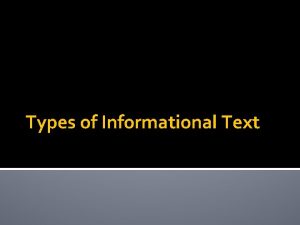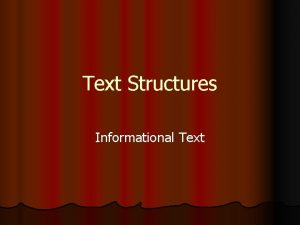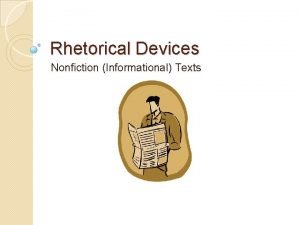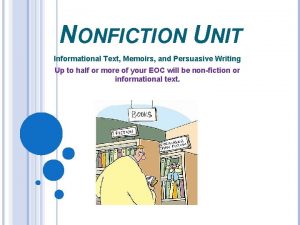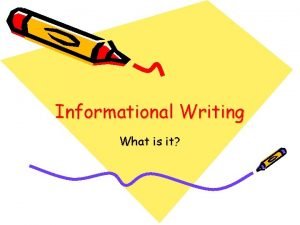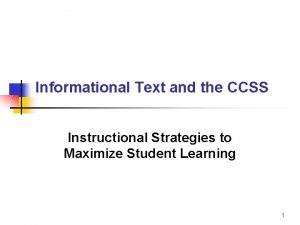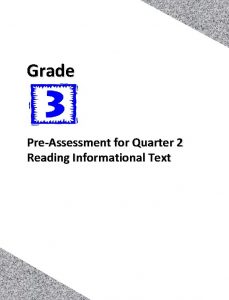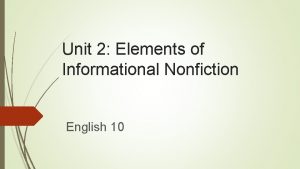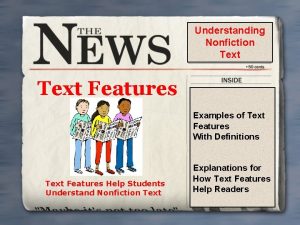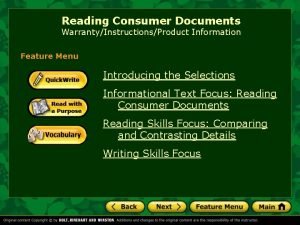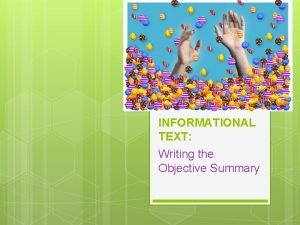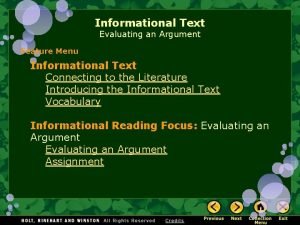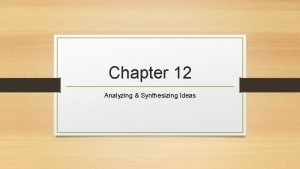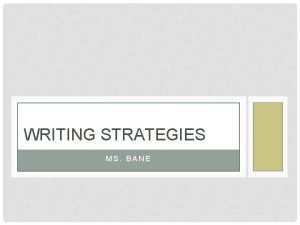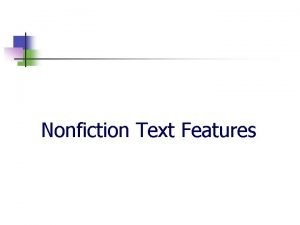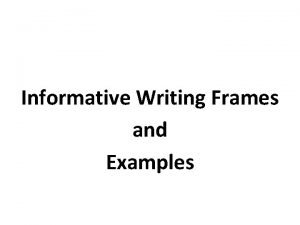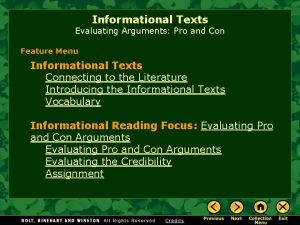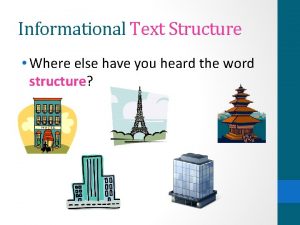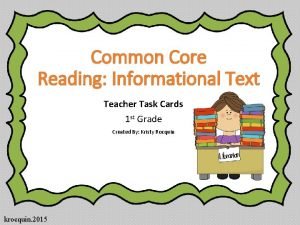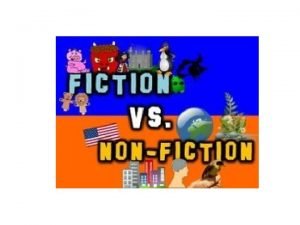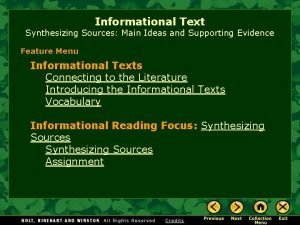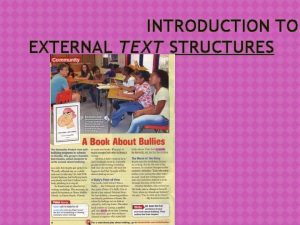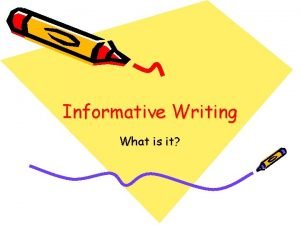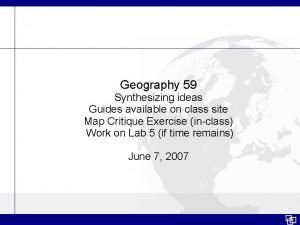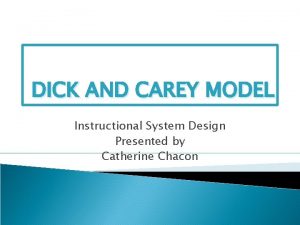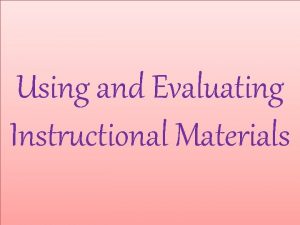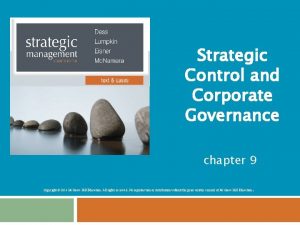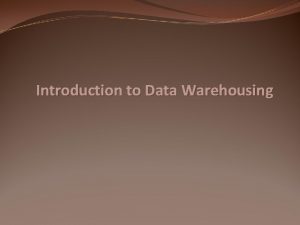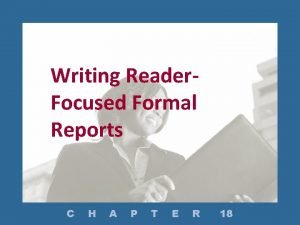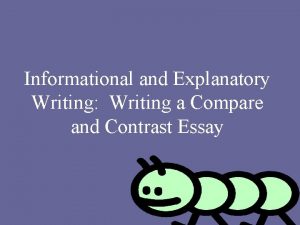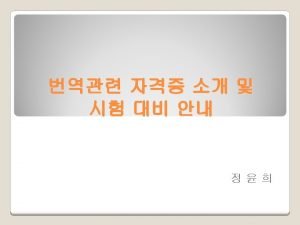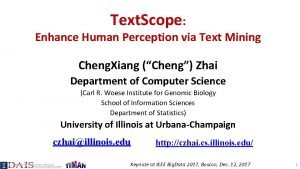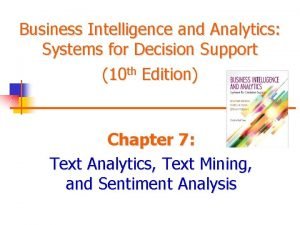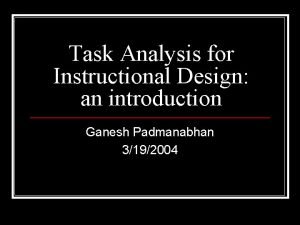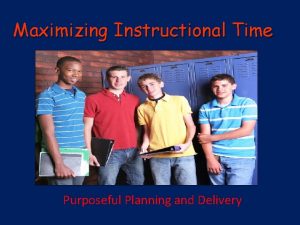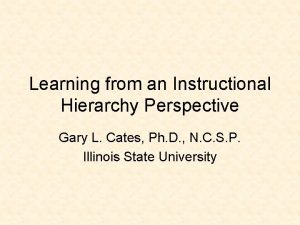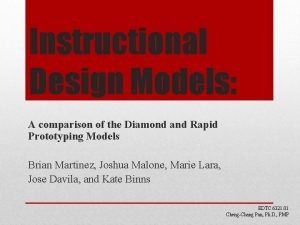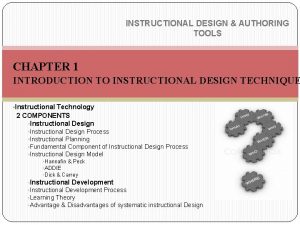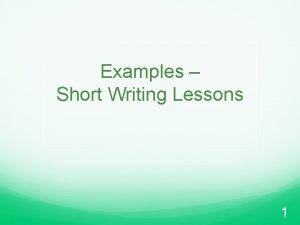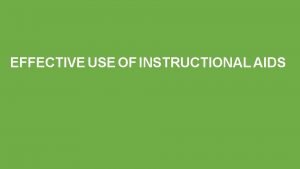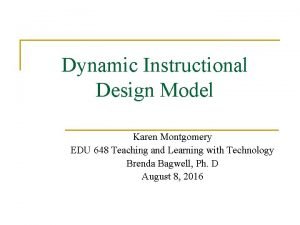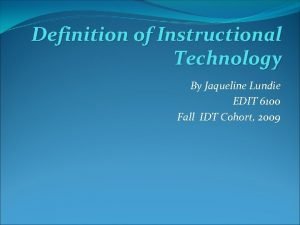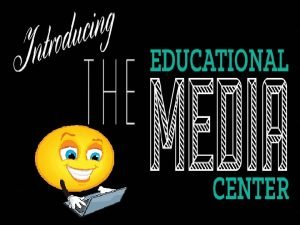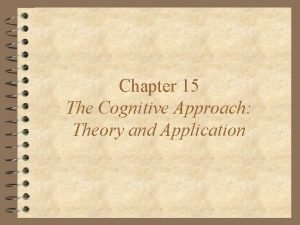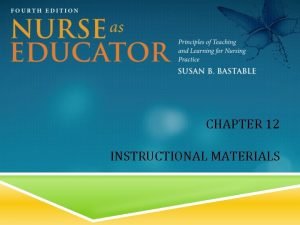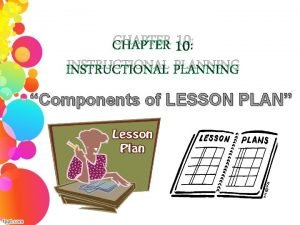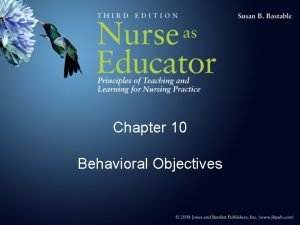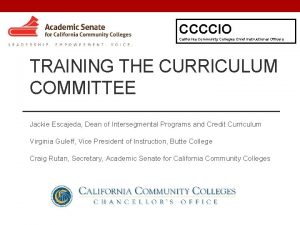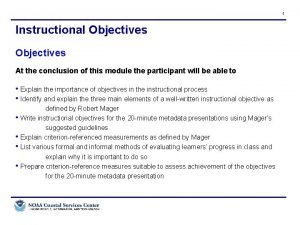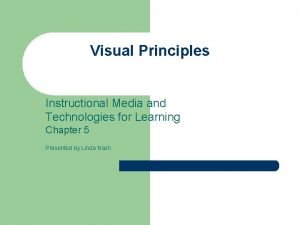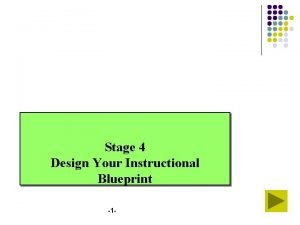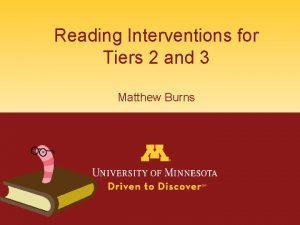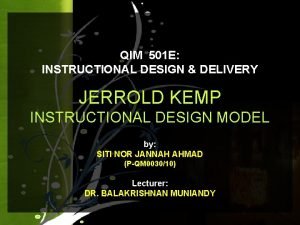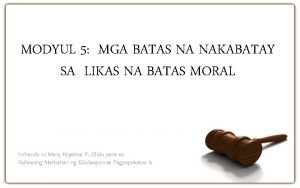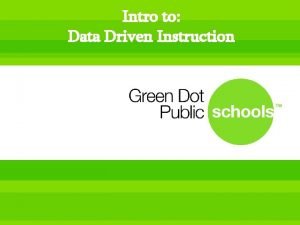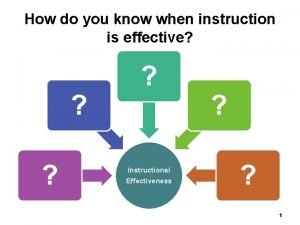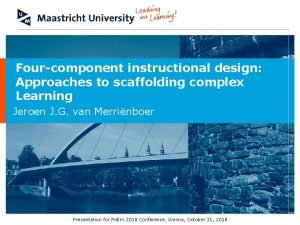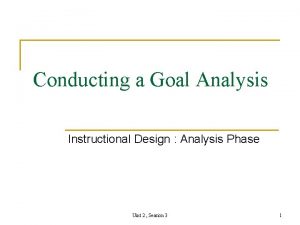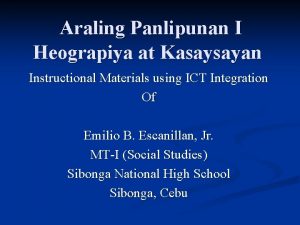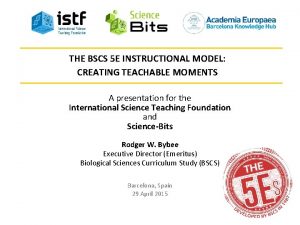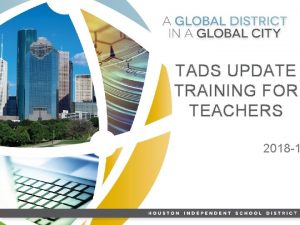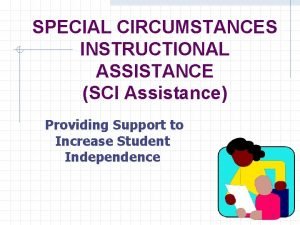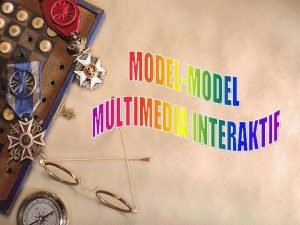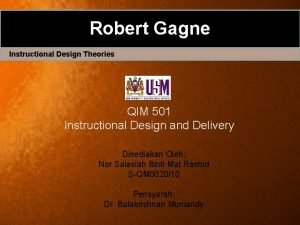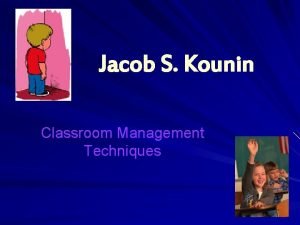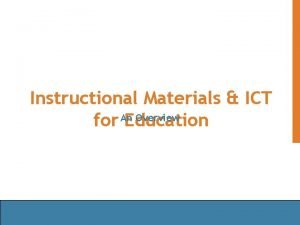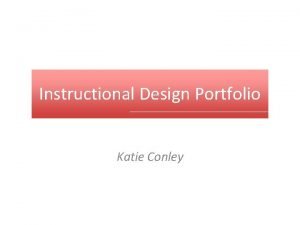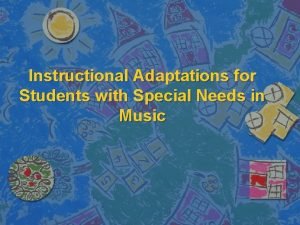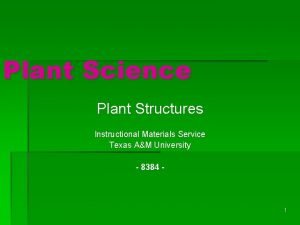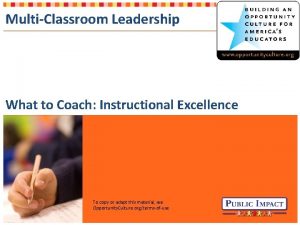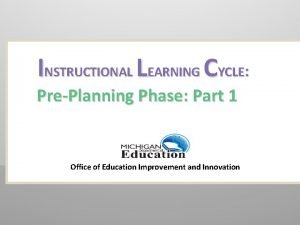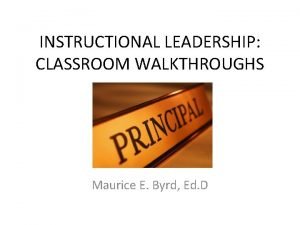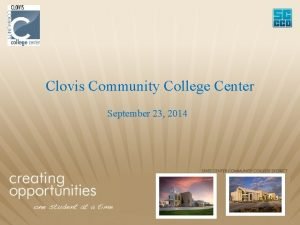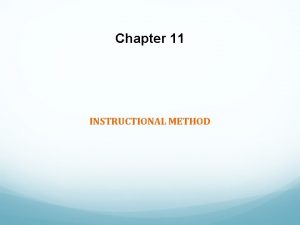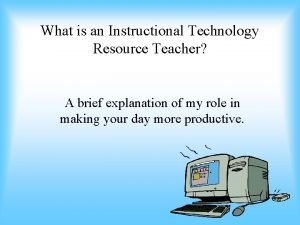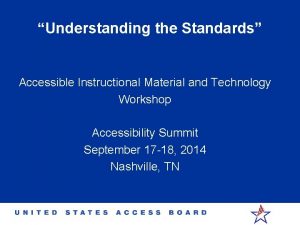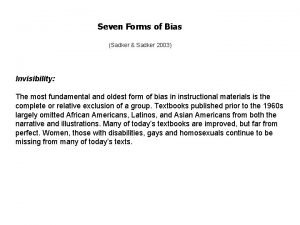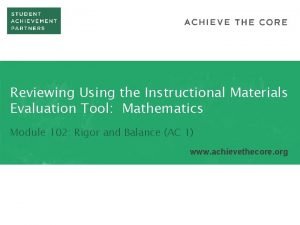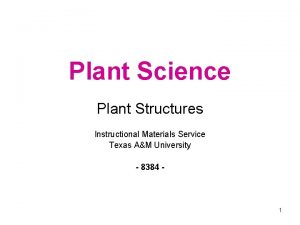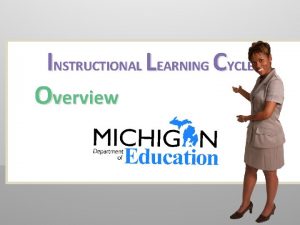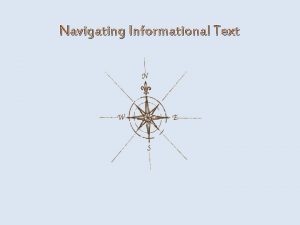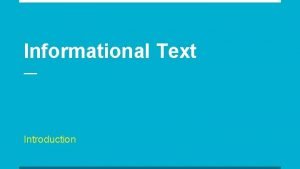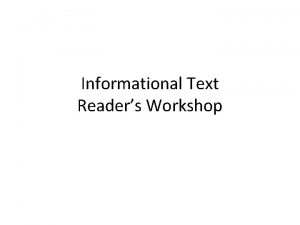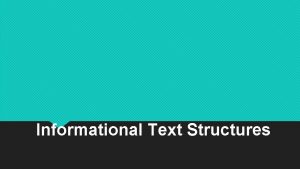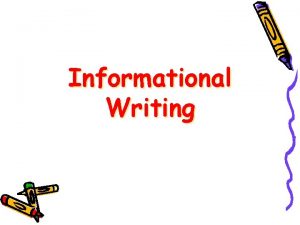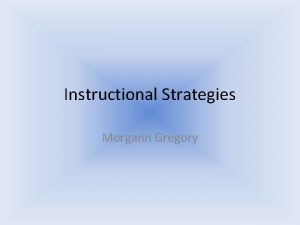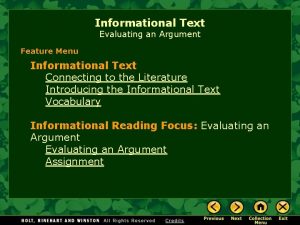Informational Text and the CCSS Instructional Strategies to



























































































































































- Slides: 155

Informational Text and the CCSS Instructional Strategies to Maximize Student Learning 1

Anita L. Archer, Ph. D Author Consultant Teacher archerteach@aol. com 2

BIG IDEAS from Common Core State Standards Informational Text What Why Where How 3

Informational Text - What The Common Core State Standards addresses informational text in the following categories: n n Exposition – factual, textbook-like reading Argument/Persuasion – texts that use argument to present a position and convince reader Procedural – step by step instructions; how-to-do something Literary Nonfiction – uses factual information within a story-like format 4

Informational Text - What Distribution of Literary and Informational Passages by Grade in the 2009 NAEP Reading Framework n n n Grade 4 Grade 8 Grade 12 Literary 50% Literary 45% Literary 30% Informational 55% Informational 70% Source: National Assessment Governing Board. (2008). Reading framework for the 2009 National Assessment of Educational Progress. Washington, DC: U. S. Government Printing Office. 5

Informational Text - Why emphasized in Common Core? n n By sixth grade, 80% of school reading tasks are expository (Venezky, 2007) 80% of adult/workplace reading is informational Standardized tests are 85% expository (Daniels, 2007) Students’ success or failure in school is closely tied to their ability to comprehend expository text (Kamil, 2003) 6

Informational Text - Where n The percentages on the table reflect the sum of student reading, not just reading in ELA settings. Teachers of senior English classes, for example, are not required to devote 70 percent of reading to informational texts. Rather, 70 percent of student reading across the grade should be informational. (Common Core State Standards, page 5) 7

Informational Text - Where Informational Text should be read in: n Language Arts Classes n n To establish background knowledge for literature To teach comprehension strategies for informational text reading To provide background knowledge of writing arguments Content Area Classes n n To convey content area information To compare information presented by various authors 8

Informational Text - What Complex Text Students should read variety of informational text: - Grade-level text Challenging, complex text 9

Informational Text - What Complex Text Features of Complex Text n n Multiple themes and purposes Density of information Unfamiliar settings, topics or events Lack of repetition 10

Informational Text - What Complex Text Features of Complex Text n n Complex sentences Uncommon vocabulary Lack of words, sentences or paragraphs that review or pull things together for the student Longer paragraphs 11

Informational Text Complex text n n n - Why expectations for what students read in the intermediate and secondary grades has declined over last 50 years cognitive demands reduced due to range of students’ learning abilities and reading and writing skills a steady downward trend across grades in the complexity of texts since 1962 12

Informational Text - Why Complex Text n students read very few informational texts n n n 7 percent of reading assignments in elementary school 15 percent in middle school students’ ability to read and comprehend challenging text predicts graduates’ postsecondary success 13

Informational Text - How Close Reading n Close reading n n n Rigorous reading of informational text Creating deep understanding Determining what text says explicitly Making logical inferences Drawing conclusions about content Examining meaning thoroughly 14

Informational Text - How Close Reading Close reading refers to the careful, systematic analysis of a text for a particular purpose. (Brummett, 2010) 15

Informational Text - How Text-Dependent Questions and Tasks n do not require information or evidence outside the text n can only be answered by careful scrutiny of text n require careful thinking about the text n require finding evidence in text to support response In other words, YOU MUST READ THE TEXT. 16

Integrate/Condense Standards Informational Text - 7 th grade Key Ideas and Details 1. Cite several pieces of textual evidence to support analysis of what the text says explicitly as well as inferences drawn from the text. Analyze - What text means Draw - Inferences Cite - Evidence 2. Determine two or more central ideas in a text and analyze their development over the course of the text; provide an objective summary of the text. Determine - Central ideas Analyze - Development of central ideas Summarize - Central ideas 17

Integrate/Condense Standards Informational Text - 7 th grade Key ideas and Details 3. Analyze the interactions between individuals, events, and ideas in a text (e. g. how ideas influence individuals and events, or how individuals influence ideas or events). analyze - how ideas influence individuals and events - how individuals influence ideas or events Craft and Structure 4. Determine the meaning of words and phrases as they are used in a text, including figurative, connotative, and technical meanings; analyze the impact of a specific word choice on meaning and tone. determine - meaning of words and phrases in text analyze - word choice 18

Integrate/Condense Standards Informational Text - 7 th grade Craft and Structure 5. Analyze the structure an author uses to organize a text, including how the major sections contribute to the whole and to the development of ideas. analyze - structure of text analyze - how sections contribute to whole Analyze the structure of text features (e. g. , graphics, headers, captions) in public documents. analyze - text features in public documents 6. Determine an author’s point of view or purpose in a text and analyze how the author distinguishes his or her position from that of others. determine - author’s point of view or purpose analyze - how author distinguishes his/her position from others 19

Integrate/Condense Standards Informational Text - 7 th grade Integration of knowledge and Ideas 7. Integrate information presented in different media or formats (e. g. , visually, quantitatively) as well as in words to develop a coherent understanding of a topic or issue. integrate - information from different sources develop - coherent understanding of topic 8. Trace and evaluate the argument and specific claims in a text, distinguishing claims that are supported by reasons and evidence from claims that are not. trace - argument and claims distinguish between - claims supported by reasons AND claims not supported 20

Informational Text - 7 th grade What text explicitly says - determine - analyze - draw inferences - cite evidence How ideas, individuals, events, influence each other - determine - analyze Structure of text - determine - analyze (parts to whole) Information from multiple sources - determine - integrate Central ideas - determine - analyze - summarize Meaning of words in text - determine - analyze word choice Author’s point of view - determine - analyze Arguments and claims - determine - analyze support 21

Fourth Grade What text says explicitly - Explain - Refer to details & examples - Draw inferences Main idea - Determine - Explain supportive details - Summarize text Events, procedures, ideas (historical, scientific, technical text) - Explain what happened and why - Use specific text info. Information – visual, oral, quantitative (Graphs, charts, diagrams, time lines) - Interpret Meaning Academic and Domain Specific Vocabulary - Determine meaning Structure of events, ideas, concepts, information - Describe - eg. , comparison, cause/effect, , problem/solution Firsthand secondhand accounts of events - Compare/Contrast - Describe different focus and information Particular points in text - Explain use of supportive reasons & evidence Two texts - Integrate information - Explain contribution of info. to text - Speak or write using information 22

Fifth Grade What text says explicitly - Explain - Draw inferences - Quote accurately Main ideas- Two or more - Determine - Explain how supported by by details - Summarize texts Relationships/Interactions between individuals, events, ideas, concepts - Explain - Use info from text Meaning Academic and Domain. Specific Vocabulary - Determine meaning Structure – events, ideas, concepts, information in two or more texts - Determine (chronology, comparison, cause/effect, problem/solution) - Compare and contrast Multiple accounts of same event - Analyze - Note similarities and differences in point of view Multiple print or digital sources - Quickly locate answer - Solve problem efficiently Particular points -Explain use of supportive reasons & evidence Multiple texts - Integrate information - Speak or write using information

Informational Text - How Preteaching n n Limit amount of preteaching Teach necessary vocabulary and background knowledge Don’t overdo so that students do not have to read the text Provide some “cold reads” 24

Informational Text - How Preteaching Example- The Jackson Era Preteaching Prepare students for reading each section of chapter. Teach critical vocabulary and necessary background knowledge. Cold Read Have students read a related article as a “cold read. ” Example: Students read Jackson’s Inaugural Address, listing his promises and then comparing those to his actions in office. 25

Summarize Big Ideas What Why Where How 26

Path to the Common Core Use research-validated practices n Comprehension n Vocabulary n Background Knowledge n Writing Use research-validated practices n Explicit Instruction n Design of Instruction n Delivery of Instruction 27

Path to the Common Core Use research-validated procedures to promote retention of information. Attend Intend Organize Rehearse 28

Learning Domain-Specific Information Attend Intend Teacher - I intend to teach critical content - This information/strategy/skill is important because…. . - We need to remember …… - The most important idea is…. - Let’s review…… Students - I intend to learn critical content - I will take notes / mark the text/ add notes in the margin/ highlight / create a web / complete graphic organizer / summarize/ …. - I will study …. 29

Learning Domain-Specific Information Organize n Big ideas (Example) n n n Problem (economic or people’s rights) Action Outcome (problem ends, problem continues, causes a new problem) Carnine, Crawford, Harness, Hollenbeck and Miller, 1998 n Graphic organizers 30

Learning Domain-Specific Information Rehearse -Repeated practice needed -The more times students process information the more likely they are to remember it. Marzano, 2004 -Students require 4 exposures to information to adequately integrate into background knowledge (within a 2 day period) Nuthall, 1999 31

Learning Domain-Specific Information Rehearse Provide judicious practice (Burke, Hagan, & Grossen, 1998) n n n Initial instruction Distributed practice Cumulative review 32

Informational Text Comprehension Before Reading During Reading After Reading 33

Preview - Before Reading Strategies • Teach the pronunciation and meaning of critical, unknown vocabulary words • Review, teach or activate any necessary background knowledge • Preview the text • Establish purpose for reading 34

Before Reading - Vocabulary n n “direct vocabulary instruction has an impressive track record of improving students’ background knowledge and comprehension of academic content” Marzano, 2001, p. 69. 97 effect size for direct teaching of vocabulary related to content Stahl & Fairbanks, 1986 35

Before Reading – Vocabulary Attributes of Good Vocabulary Instruction 1. Promote word learning strategies 2. Select words that enhance academic success General Academic Vocabulary - Generalize across domains (evidence, observe, investigate, classify, compared to, alternatively, in contrast) - Domain-Specific Vocabulary - Specific to a domain or field of study (suffrage, prokaryote) 3. Order or group words semantically 36

Before Reading – Vocabulary Attributes of Good Vocabulary Instruction 4. Teach words using explicit instruction 5. Provide student-friendly explanations 6. Teach parts of words at the “moment of opportunity” (biology - bio = life; autoimmune - auto =self 7. Provide multiple exposures to terms and meanings 37

Before Reading – Vocabulary Attributes of Good Vocabulary Instruction 7. Expand instruction to “word relatives” (category, categories, categorization, categorizer) 8. Have students maintain vocabulary log 9. Maintain a word wall 10. Provide judicious review 38

Before Reading - Vocabulary n n Limit number of words given in depth instruction to 4 to 5 words (Robb, 2003) Select words that are unknown Select words that are critical to passage understanding Select words that students are likely to use in the future (Stahl, 1986) n n General academic vocabulary used in many domains Domain-specific vocabulary that provides background knowledge 39

Before Reading - Vocabulary n Select difficult words that need interpretation n Words not defined within the text n Words with abstract referent n Words with an unknown concept (NOTE: Be aware of words that are used differently in your subject. theory - hunch VS in science a well-established explanation) 40

Selection - Vocabulary Text: American Journey Chapter 11, Section 1 Publisher: Glencoe Jacksonian Democracy favorite son majority plurality mudslinging landslide nullify nominating tariff convention secede suffrage 41

Selection - Vocabulary Text: My World Publisher: Pearson Chapter 4, Section 3 Central America and the Caribbean Today * carnival * Santeria * diaspora *microcredit * ecotourism indigenous democracy parliamentary system dictatorship free-trade agreements 42

Before Reading - Vocabulary n n Dictionary Definition n compulsory - (1) Employing compulsion; coercive. (2) Required by law or other rule. Student-Friendly Explanation n Uses known words. n Is easy to understand. n When something is compulsory, it is required and you must do it. 43

On-line Dictionaries with Student-friendly Explanations Collins Cobuild Dictionary of American English http: //www. collinslanguage. com/free-online-cobuild-ESL-dictionary. reverso. net/english/cobuild Longman’s http: //www. ldoceonline. com (Longman’s Dictionary of Contemporary English Online) Heinle’s http: //www. nhd. heinle 17 e. com/home. aspx (Heinle’s Newbury Dictionary for American English) Merriam Webster’s http: //www. learnersdictionary. com (Pronunciation assistance: www. howjsay. com 44

Before Reading - Vocabulary Step 1. Introduce the word. a) b) c) d) e) Write the word on the board or overhead. Read the word and have the students repeat the word. Have students tap out the syllables in the word. Have students read the word by parts as you loop under the word. Have students repeat the pronunciation of the word. (If the word is difficult to pronounce or unfamiliar have the students repeat the word a number of times. ) Introduce the word with me. This word is suffrage. What word? suffrage Tap and say the parts of the word. suf frage Again. suf frage What word? suffrage Suffrage is a noun. 45

Before Reading - Vocabulary Step 2. Introduce meaning of word. Option # 1. Present a student-friendly explanation. a) b) Tell students the explanation. OR Have them read the explanation with you. Present the definition with me. When someone has suffrage, they have the right to vote in an election. 46

Before Reading - Vocabulary Step 2. Introduce meaning of word. Option # 2. Have students locate the definition in the glossary or text and break the definition into the critical attributes OR present the word in parts. Glossary: Suffrage - the right to vote suffrage - the right - to vote 47

Before Reading - Vocabulary Step 2. Introduce meaning of word. Option # 3. Introduce the word using the meaningful parts in the word. autobiography auto = self bio = life graph = letters, words, or pictures hydroelectricity hydro = water NOTE: 88% of key science words have Spanish cognates; 1/2 are high frequency words in Spanish 48

Common Latin and Greek Roots aqua water Greek aquarium, aqueduct, aquaculture, aquamarine, aquaplane, aquatic aud hearing Latin audio, audition, audiovisual, auditorium, audiotape, inaudible auto self Greek autograph, autobiography, automobile, autocrat, autonomy astro star Greek astronomy, astrophysics, astrology, astronaut, astronomer, asterisk biblio book Greek Bible, bibliography, bibliophobia, bibliophile, biblioklept bio life Greek biography, biology, autobiography, bionic, biotic, antibiotic, biome, bioshere, biometrics chrono time Greek synchronize, chronology, chronicle, anachronism corp body Latin corpse, corporation, corps, incorporate, corporeal, corpulence demo the people Greek democracy, demography, epidemic, demotic, endemic, pandemic dic, dict speak, tell Latin dictate, dictation, dictator, verdict, predict, contradict, benediction, jurisdiction, predict, indict, edict dorm sleep Latin dormant, dormitory, dormer, dormouse, dormition, dormitive geo earth Greek geology, geologist, geometry, geographer, geopolitical, geothermal, geocentric 49

Common Latin and Greek Roots graph to write, to draw Greek autograph, biography, photograph, telegraph, lithograph hydro water Greek hydroplane, dehydrate, hydroelectric, hydrogen, hydrophone ject throw Latin reject, deject, project, injection, projection logos, logy study Greek geology, astrology, biology, numerology, zoology, technology, psychology, anthropology, mythology luna moon Latin lunar, lunacy, lunatic, interlunar meter measure Greek meter, thermometer, diameter, geometry, optometry, barometer, centimeter, symmetry, voltammeter mega great, large, big Greek megaphone, megalith, megalomania, megatons, megalopolis min small, little Latin minimal, minimize, minimum, miniature, minuscule, minute, minority mit, mis send Latin mission, transmit, transmission, remit, missile, submission, permit, emissary path feeling, suffering Greek pathetic, pathology, apathy, antipathy, sympathy, telepathy, empathy, sociopath ped foot Latin pedestrian, pedal, peddler, pedicure, pedometer philia love, friendship Greek philosopher, Philadelphia, philanthropist, philharmonic, 50 Philip

Common Latin and Greek Roots phono sound Greek phonograph, microphone, symphony, telephone, phonogram, megaphone, phony, euphony, xylophone, phony, photo light Greek photograph, photosynthesis, telephoto, photometer, photophilia port carry Latin port, transportation, portable, portage, report spect see Latin respect, inspection, inspector, spectacles, prospect scope look at Greek microscope, telescope, periscope, kaleidoscope, episcopal sol sun Latin solar, solar system, solstice, solarium, parasol struct build, form Latin instruct, instruction, construction, reconstruction, destruction, infrastructure, construe, instrumental tele distant Greek telephone, television, telegraph, telephoto, telescope, telepathy, telethon, telegenic terra land Latin territory, terrestrial, terrace, terrarium, extraterrestrial, Mediterranean Sea, terra cotta, subterranean 51

Vocabulary n Recommended resource for science teachers The Sourcebook for Teaching Science by Norman Herr Chapter 1, Building a Scientific Vocabulary contains lists of roots, prefixes, suffixes by science domain 52

Before Reading - Vocabulary Step 3. Illustrate the word with examples. a. Concrete examples - objects - acting out b. Visual examples c. Verbal examples 53

Before Reading - Vocabulary Suffrage Examples When the United States was founded only white men with property had suffrage. At the time of the American Civil War, most white men had been granted suffrage. 54

Before Reading - Vocabulary Suffrage Examples In 1920, women were granted suffrage. The passage of the Nineteenth Amendment granted women the right to vote in all United States elections. 55

Before Reading - Vocabulary Suffrage Examples The Voting Rights Act of 1965 outlawed discriminatory voting practices that denied suffrage to many African Americans in the United States. 56

Before Reading - Vocabulary Step 4. Check students’ understanding. Option #1. Ask deep processing questions. Check students’ understanding with me. Why is suffrage a critical aspect of a democracy? Begin by saying or writing: Suffrage is a critical aspect of democracy for the following reasons. First, ______ 57

Before Reading - Vocabulary Step 4. Check students’ understanding. Option #2. Have students discern between examples and non-examples. Check students’ understanding with me. Tell me suffrage or not suffrage. The right to run for elected office. not suffrage Why not? The right to vote. suffrage Why? The right to develop ads for a candidate. not suffrage Why not? 58

Before Reading - Vocabulary Step 4. Check students’ understanding. Option #3. Have students generate their own examples. Check students’ understanding with me. Make a list of ways that suffrage could be limited or compromised. 59

Before Reading - Vocabulary suffrage suffragist noun In 1917, all women in the United States did not have suffrage, the right to vote. Suffragists in New York City collected more than a million signatures of women demanding voting rights. They then paraded down Firth Avenue with the signature placards. 60

Background Knowledge - What n …. what one already knows about a subject. Stevens, 1980 n …all the knowledge learners have when entering a learning environment that is potentially relevant for acquiring new knowledge. Biemans & Simons, 1996 61

Background Knowledge - Why n Background knowledge of text has a major impact on whether or not a reader can comprehend text. Anderson & Pearson, 1984; Bransford, Stein, & Shelton, 1984; Wilson & Anderson, 1986 n Across grades and reading ability, prior knowledge of subject area and key vocabulary results in higher scores on reading comprehension measures. Langer, 1984; Long, Winograd, & Bridget, 1989; Stevens, 1980 62

Background Knowledge - Why n n Average correlation between person’s background knowledge of a given topic and extent to which a person learns new information is. 66. Marzano, 2004 Prior knowledge has a large influence on student performance, explaining 30 to 60% of variance in performance. Docy, Segers, & Buehl, 1999 63

Background Knowledge - Why? Read this paragraph and explain it to your partner. From a neuroanatomy text (found in Background Knowledge by Fisher and Frey) Improved vascular definition in radiographs of the arterial phase or of the venous phase can be procured by a process of subtraction whereby positive and negative images of the overlying skull are imposed on one another. 64

Background Knowledge - Why? Read this paragraph and explain it to your partner. ( Background Knowledge by Fisher and Frey) How much a reader already knows about the subject is probably the best predictor of reading comprehension. When readers engage with a text for which they have limited background knowledge, the text is much more difficult to understand than one for which they have ample background knowledge. …research indicates that children continue to spin their wheels when they don’t have the background knowledge required to understand much of what they are reading. p 2 65

Background Knowledge Approaches 1. Review what has been taught 2. Teach necessary background knowledge 3. Activate background knowledge 66

Background Knowledge Review critical information what has been recently taught Review is always ASK - Review is interactive - Adjust lesson based on responses - 67

Background Knowledge Review and Teach When teaching factual information, remember: Attend Intend Organize Rehearse 68

Teach Background Knowledge BIG IDEA Even a thin slice of background knowledge is useful. 69

Teach Background Knowledge Preparation 1. What is critical? 2. What information would ease acquisition of new knowledge? 3. What information would reduce cognitive overload? 4. What information will increase interest and motivation? 70

Teach Background Knowledge Anchor Instruction in: n Supplementary Informational Text n Power-point n Visuals n Video 71

Chapter 11 The Jackson Era 1824 -1845 Section 1 Jacksonian Democracy 72

Main Idea The political system of the United States changed under Andrew Jackson. As you read, ask yourself: What changes in the political system of the United States occurred under Andrew Jackson? 73

Andrew Jackson Background knowledge President n 7 th President n 1829 - 1837 Early Life n Parents emigrated from Ireland n Father died before his birth n Mother died when he was 14 n Two brothers also died 74

Andrew Jackson Background knowledge Career - Military n At 13 joined Continental Army n Major General of Tennessee Militia n Lead campaign against Creek Indians in Georgia n In 1815 lead military victory over British at the Battle of New Orleans 75

Andrew Jackson Background knowledge Career - Politician n Lawyer n US Representative n US Senator n Circuit Judge n President 76

Andrew Jackson Background knowledge Personal Life n Married Rachel Jackson n Two adopted children n Owned large cotton plantation with 150 slaves n Killed man in pistol duel 77

Teach Background Knowledge Anchor in Video Clip n n n Select well-crafted video. n Appropriate length n Major points stressed n Matches necessary background knowledge Scaffold “information dense videos” (e. g. , watch more than one time, provide limited focus for each viewing) Opportunity to focus on visual literacy skills. (Cena & Mitchell, 1998) 78

Teach Background Knowledge Anchor in Video Clip - Instructional Procedure 1. 2. Focus: Establish a focus for watching the video. Response: Ask students to take notes, complete partial notes, or complete a think sheet or other graphic organizer. Tell students that they will be sharing with their partners. 3. Share: Have students share their observations with their partners or team. 4. Discuss: Lead students in a discussion of the main ideas from video. 5. Review/Rehearse: Ask students questions on the critical content. 79

Activate Background Knowledge n n Evidence-based Procedures n Reflection and Recording n Anticipation guide n Semantic Mapping Purposes n n activate background knowledge assess entering level of knowledge 80

Activate Background Knowledge Reflection and Recording 1. Have students state, write down, or record what they know about the topic. What do I already know about this topic? Carr & Thompson, 1996; Peeck, van dem Bosh & Keupling, 1982; Smith, Readence & Alvermann, 1983; Spires & Dontey, 1998; Walraven & Reitsma, 1993 2. After reflecting and recording, engage students in a group discussion of the topic. Dole, et. al, 1991; Schmidt & Patel, 1987; King, 1994; Hansen & Pearson, 1983. 81

BUT………. n Teacher-directed instruction focused on information necessary for understanding text, more effective than activating student knowledge and discussing it. Dole, Valencia, Greer, & Wardrop, 1991 82

Activate Background Knowledge Anticipation Guide 1. 2. 3. 4. 5. The teacher reads the chapter and determines the most important ideas that students should gain. These ideas are expressed in statements that are either true or false statements. Before reading the chapter, the students read each statement and indicate if they believe the statement is true or false based on their current background knowledge. After reading the chapter and participating in other learning activities, the students read each statement and indicate if they believe the statement to be true or false based on their expanded knowledge. (Optional) Students rewrite false statements, creating true statements. In the end, the students will have a summary of key ideas. 83

Activate Background Knowledge Anticipation Guide 1. 2. 3. 4. 5. The teacher reads the chapter and determines the most important ideas that students should gain. These ideas are expressed in statements that are either true or false statements. Before reading the chapter, the students read each statement and indicate if they believe the statement is true or false based on their current background knowledge. After reading the chapter and participating in other learning activities, the students read each statement and indicate if they believe the statement to be true or false based on their expanded knowledge. (Optional) Students rewrite false statements, creating true statements. In the end, the students will have a summary of key ideas. 84

Anticipation Guide- Example Before Study After study Statements Directions: Mark each statement true or false. 1. Mohammed, the prophet of Islam, was born more than 500 years after Jesus. 2. Mohammed believed that there was only one God, Allah. 3. Mohammed destroyed the idols that were in the temple in Mecca. 4. The word Islam means remission. Mohammed told his followers that they should seek remission of their sins. 5. Mohammed, like Jesus, is worshiped by his followers as God. Continue on next slide. 85

Anticipation Guide- Example 6. Five times a day, Muslims face the holy city of Medina and pray. 7. Islam teaches concern for the poor. 8. It takes many years to become a clergy member in the Islam faith. Few people reach this level. 9. The Koran, the Muslim’s holy book, is written in the original Greek language of Mohammed. 86

Activate Background Knowledge Semantic Mapping 1. 2. 3. 4. Have students generate a list of words that they associate with the concept. Next, have students generate categories for the words. Then, students record words from their list with a matching category. Semantic mapping can be done individually, in pairs, or in cooperative teams. 87

Preview - Informational Passage As the student previews, he/she discovers: n the topics to be covered, n the information that will be emphasized, n how the material is organized. n In addition, background knowledge is activated. 88

Preview - Informational Passage n n Guide students in previewing the chapter and formulating a topical outline using the text structure: title, introduction, headings, subheadings, questions. Has students preview the selection independently, with his/her partner, or with team members. 89

Preview - Informational Passage Warm-Up Before you read a chapter or a section of a chapter in your science, social studies, or health book, Warm-up. Get an idea of the chapter’s content by previewing these parts. BEGINNING n Title n Introduction MIDDLE n Headings n Subheadings END n Summary n Questions Curriculum Associates, Skills for School Success 90

Jacksonian Democracy The Election of 1824 Striking a Bargain The Adams Presidency The Election of 1828 Jackson Triumphs Jackson as President “Old Hickory” New Voters The Spoils System Electoral Changes 91

Establish Reading Purpose Establish the reading purpose using: n the objectives provided in the text. n the essential question. 92

Preview During Reading Strategies n Utilize passage reading procedures that provide adequate reading practice n Ask appropriate questions during passage reading n Have students generate questions n Teach text structure strategies that can be applied to passage reading 93

Passage Reading Procedures n What are some disadvantages of “round -robin reading” when the group size is large? 94

Passage Reading - Silent Reading Augmented Silent Reading n n Pose pre- reading question Tell students to read a certain amount and to reread material if they finish early Circulate and monitor students’ reading Have individuals whisper-read to you Pose post- reading question 95

Passage Reading - Choral Reading n Read selection with your students n Read at a moderate n Tell your students, “Keep your voice with mine” (You may wish to have the students pre-read the material silently before choral reading. ) 96

Passage Reading - Cloze Reading n Read selection n Pause on “meaningful” words and have students read the word OR Read the first part of the sentence and have students read the rest of the sentence n Have students read the deleted words Excellent practice for reading initial part of a chapter or when you need to read something quickly 97

Passage Reading - Individual Turns n Use with small groups n Call on an individual student n Call on students in random order n Vary the amount of material read If used with large group, n n Assign paragraphs for preview and practice OR Utilize the me or we strategy. When called on, student has the option of saying “we” and asking everyone to join in reading. 98

Passage Reading - Partners Partner Reading n Assign each student a partner n Reader whisper-reads to partner n n n Narrative - Partners alternate by sentence, page, or time Informational text - Partners alternate by the paragraph (Read - Stop - Respond). Coach corrects errors. Ask - Can you figure out this word? Tell - This word is _____. What word? Reread the sentence. 99

Passage Reading - Partners Alternatives to support lowest readers n n n Option #1 Higher reads material. Lower reader in partnership reads same material. Option #2 Lowest reader placed on a triad and reads with another student Option #3 Partners allowed to say “me” or “we” 100

Comprehension. Informational Text Reading n n n Read Stop Respond n n n n answer teacher questions generate questions/answer questions verbally retell content “Paragraph shrinking” mark text /notes in margin take notes (Cornell Notes, Foldables) map/web content 101

During Passage Reading Read Stop Respond -Teacher Asks Questions - Students Answer Questions 102

During Passage Reading Ask Questions Asking questions. A evidence-based, time honored procedure The teacher asks questions to guide and monitor students’ comprehension (Ambruster, Lehr, & Osborn, 2001; National Reading Panel, 2000; Mc. Keown, Beck, & Blake, 2009) ) 103

During Reading Strategies Ask Questions Why do we ask questions on what has been read? 104

During Reading - Ask Questions Curriculum Questions n Ask questions provided by the curriculum material. OR The Teacher-Generated Questions n Divide the material into appropriate segments. n Develop questions on the content, focusing on the most important understanding that students should construct. 105

During Reading - Ask Questions 1. Ask text-dependent questions. - The student must read the text to respond to the question. 2. Ask higher order questions - Inferences, predictions, comparisons, summaries 3. Scaffold higher order questions with foundation questions on key details 4. Scaffold answers with sentence starters 5. Use appropriate active participation procedures for asking questions 106

During Reading Text-Dependent Questions Ask questions that focus on information (evidence) provided in the text. Students must answer the questions based on passage information NOT on previous experience or personal ideas. Keep students cognitively in the text… don’t draw them out of the text. 107

During Reading - Text Dependent Questions Fisher & Frey, 2012 Whole Across Texts Opinions, arguments, intertextual connections Inferences Entire Texts Author’s Purpose Paragraph Vocabulary Sentence Key Details Word Part General Understanding 108

During Reading Scaffold Higher Order Questions n n n If the question is a difficult, higher order question, scaffold (support) the students’ performance. Ask lower order (literal) questions first to establish a foundation on which higher order responses can be based. Provide a verbal or written sentence starter. 109

During Reading Scaffold Higher Order Questions Elementary Example Support student responding by providing sentence starters (stems). In what ways are emperor penguins different from other birds you know about? Begin by saying: Emperor penguins are different from other birds in a number of ways. First, …………… 110

During Reading Scaffold Higher Order Questions Scaffolding Questions: Can penguins fly? Does the mother or the father penguin sit on the egg to keep it warm? Does the father penguin stay alone or with a group? Big Question to be asked: In what ways are emperor penguins different from other birds you know about? Begin by saying: Emperor penguins are different from other birds in a number of ways. First, …………… 111

During Reading Scaffold Higher Order Questions (Secondary Example) Scaffolding Questions How many political parties were there in 1824? Four men in the party ran for president. Did Andrew Jackson get a majority of votes? Which of the 4 candidates received the most votes? Who did the House of Representatives select as president? Who helped Adams to be elected as president? What position in the government was Clay given? Big Question to be asked: Why were Adams and Clay accused of making a “corrupt bargain” (stealing the election)? 112

During Reading - Ask Questions Procedure for asking students questions on text material. Saying answer to partner (Partners First) 1. Ask a question 2. Give students thinking time or writing time 3. Provide a verbal or written sentence starter or paragraph frame 4. Have students share answers with their partners using the sentence starter 5. Call on a student to give answer 6. Engage students in a discussion ��� 113

During Reading - Ask Questions Discussion n n Have students discuss responses to question, task, or directive Scaffold the discussion with sentence starters 114

During Reading - Ask Questions Discussion sentence starters Disagreeing I disagree with ____ because ______. I disagree with ____. I think _______. Agreeing I agree with ______ because _______. I agree with ______ and I also think _____. ���� 115

During Reading - Asks Question Adapted from presentation by Kate Kinsella, Ph. D Structured Discussion Agreeing My idea is similar to _____ idea. I think______ My ideas expand on _____ idea. I think ______ I agree with ______ and want to add________ Disagreeing I don’t agree with _____ because ________ I have a different perspective from _______. I think____ My views are different from ______. I believe______ 116

During Reading - Ask Questions Adapted from presentation by Kate Kinsella, Ph. D Structured Discussion Clarifying Will you please explain _____________ What did you mean when you stated _______ Could you please clarify your idea for me. Paraphrasing What I hear you saying is ____________ So you believe ________________ 117

During Passage Reading Read Stop Respond - Students generate questions - Students answer questions 118

During Reading - Students generate and answer questions Student-Generated Questions based on Headings and Subheadings 1. 2. 3. 4. Read the heading or subheading. Generate one or two questions. Read the section. Answer the question. 119

Classifying Rocks Question How do you classify rocks? Answer Rocks are classified by mineral composition, color, and texture. How are rocks classified? 120

How Rocks Form Question Answer Igneous rocks How do igneous rocks form? Sedimentary rocks How do sedimentary rocks form? Metamorphic rocks How do metamorphic rocks form? 121

How Rocks Form Question Igneous rocks Answer Igneous rocks are formed when magma or lava cools. Sedimentary rocks Metamorphic rocks 122

Student-Generated Questions Question-Answer Relationships n Taffy Raphael, 1984 Right There. The answer is in the text, and if we pointed at it, we'd say it's "right there!" Often, the answer will be in a single sentence or place in the text, and the words used to create the question are often also in that same place. 123

Student-Generated Questions Question-Answer Relationships n Taffy Raphael, 1984 Think and Search. The answer is in the text, but you might have to look in several different sentences to find it. It is broken up or scattered or requires a grasp of multiple ideas across paragraphs or pages. 124

Student-Generated Questions Question-Answer Relationships n n Taffy Raphael, 1984 Author and You. The answer is not in the text, but you still need information that the author has given you, combined with what you already know, in order to respond to this type of question. On My Own. The answer is not in the text, and in fact you don't even have to have read the text to be able to answer it. (Not text-dependent. ) 125

During Passage Reading Read Stop Respond -Students create main idea statements -Students respond to teacher or partner questions 126

During Reading - Students generate main idea statements Paragraph Shrinking 1. Name the who or what. (The main person, animal, or thing. ) 2. Tell the most important thing about the who or what. 3. Say the main idea in 10 words or less. (Optional: Record your main idea sentence. ) (From the PALS program by Fuchs, Mathes, and Fuchs) 127

During Reading - Paragraph Shrinking (Elementary Example) (I do it. ) The Coldest Continent Antarctica is not like any other continent. It is as far south as you can go on earth. The South Pole is found there. Ice covers the whole land. In some places the ice is almost three miles thick. Beneath the ice are mountains and valleys. 128

During Reading - Paragraph Shrinking (Elementary Example) (We do it. ) The weather in Antarctica is harsh. It is the coldest place on Earth. The temperature does not get above freezing. It is also one of windiest places in the world. 129

During Reading - Paragraph Shrinking (Elementary Example) (You do it. ) Not many living things are found in Antarctica. People go there to study for only a short time. Very few animals can live there. Yet many animals live on nearby islands. Seals and penguins swim in the ocean waters. They build nests on the land. Some birds spend their summers in Antarctica. But most of the continent is just ice, snow, and cold air. 130

During Reading - Students generate written main idea statements (Secondary Example) I do it. Types of Rocks One type of rock is igneous rock. Igneous means “fire-made. ” Deep inside earth, rock is heated by the great weight of the rock above pressing down. The rock is heated so much that it melts becomes the liquid rock called magma. Sometimes magma pushes its way through cracks in the bedrock and spreads over the ocean floor. Other times it explodes from the ground as lava from a volcano. More often, magma rises only to earth’s crust where it cools. As magma cools, it forms crystals and becomes igneous rock. Sometimes it cools so quickly that crystals do not form, and the lava turns into volcanic glass, called obsidian. Granite is another common igneous rock. 131

During Reading - Students generate written main idea statements (Secondary Example) Record your main idea sentence Igneous rock is formed when magma, liquid rock, cools. 132

During Reading - Paragraph Shrinking (Secondary Example) We do it. The second type of rock is sedimentary. Earth builds sedimentary rock layer by layer. Forces such as wind, water, and ice cause rocks to break down into smaller pieces of rock and minerals. This soft material, called sediment, flows into river or sea beds where it is deposited in layers. Over thousands of years, the great weight of the sediment on the top compresses the pieces of the deeper sediment. At the same time, certain chemicals in the water act as a glue that cements the bits and pieces into a a solid mass. Thousands or millions of years later, the old sea floor may be thrust up as dry land, exposing the sedimentary rock layering. Sandstone, shale, conglomerate, and limestone are all examples of sedimentary rock. 133

During Reading - Paragraph Shrinking (Secondary Example) You do it. The third type of rock is metamorphic. The word metamorphic means “changed in form. ” Metamorphic rock is formed when igneous and sedimentary rocks are exposed to great heat and pressure. Metamorphic rocks are almost always found deep in young mountain ranges as rocks are folded and compressed beneath other rocks. Slate and marble are examples of metamorphic rock. From Advanced Skills for School Success published by Curriculum Associates 134

During Passage Reading Read Stop Respond - Students “mark” the text - Students write notes in the margins 135

During Reading - Students “mark” the text 1. Number the paragraphs 2. Circle the topic and/or topic sentence 3. Underline supportive details 136

During Reading - Students write notes in the margins n Notes in the margin might include: - A summary of the content - Key vocabulary terms and definitions - A drawing to illustrate a point - Responses to interesting information, ideas, or claims 137

During Passage Reading Read Stop Respond - Students take notes - Students map/web the content 138

During Reading - Students take two column notes Antarctica - far south continent - South Pole - Covered with ice Weather - Harsh - Below Freezing - Windy Living Things - Few Antarctica, the most southern continent, has very harsh weather and is covered in ice. Few living things survive on Antarctica. 139

During Reading - Students map or web the content Land Weather -far south -South Pole -covered w/ice -harsh -below freezing -windy Antarctica Living Things - few can survive 140

Preview n n After Reading Strategies Have students complete or generate graphic organizers that summarize critical information Have students write in response to passage: n Summary n Compare and Contrast n Opinion 141

After Reading - Graphic Organizers The teacher: n Provides students with a graphic organizer that reflects the structure of the text material. n n n Central Idea Hierarchy Compare/Contrast Sequence of Events Cause/Effect Problem/Solution 142

After Reading - Graphic Organizers n After completing the graphic organizer, students: n n n Teach the content on the graphic organizer to their partners Use the graphic organizer as a support during class discussions Write a summary of the content based on the graphic organizer 143

Write a Summary - Writing Frames Antarctica is the coldest continent on the earth. The land is covered with _____________. The temperature stays below _________ and the _______ constantly blow. Because of these conditions, not many ______ things are found on this continent. 144

Write a Summary - Writing Frames Summary of Informational Text Chapter: _____ Topic: ________ n n n n In this section of the chapter, a number of critical points were made about … First, the authors pointed out that… This was important because… Next, the authors mentioned that… Furthermore, they indicated… This was critical because… Finally, the authors suggested that… 145

Write a Summary - Writing Frames Chapter: Drifting Continents Topic: Wegener's Theory n In this section of the chapter, a number of critical points were made about Alfred Wegener's theory of continental drift. First, the authors pointed out that Wegener believed that all the continents were once joined together in a single land mass that he called Pangaea that drifted apart forming the continents of today. This was important because it explained why the outline of the continents as they are today fit together. Next, the authors mentioned that Wegener argued that there were many pieces of evidence supporting his theory of continental drift. Furthermore, they indicated that Wegener used evidence of similar landforms and fossils on different continents to prove his theory. This was critical because this evidence could be validated by other scientists. Finally, the authors suggested that despite this evidence, other scientists did not accept Wegener's theory because he could not explain the force that pushes and pulls the continents. 146

Write a Summary - Writing Frames Summary of Opinion Article n n n n n Name of Article: … Author: … Topic: … In this article, _____. discusses… The author's primary claim is that. . First, she/he states…. She/he then points out that. . . In addition, ______, indicates that…. Finally, she/he conclude…. . 147

Write a Summary - Writing Frames Summary of Opinion Article n n n n n Name of Article: … Author: … Topic: … In this article, _____. discusses… The author's primary claim is that. . First, she/he states…. She/he then points out that. . . In addition, ______, indicates that…. Finally, she/he conclude…. . 148

Write a Summary - Writing Frames Name of Article: The Writing Revolution Magazine/Journal: the Atlantic (September, 2012) Author: Peg Tyre Topic: Writing Instruction In this article, Peg Tyre discusses writing instruction in today's schools. The author's primary claim is that a return to traditional, explicit instruction on the fundamentals of writing could be the answer to poor writing exhibited in schools. First, she states that teachers at New Dorp High School determined that their students poor performance was due to the fact that they could not express their ideas on paper. She then points out that when New Dorp adopted intense, explicit instruction on the skills of analytic writing, test scores and graduation rates improved. In addition, Tyre indicates that thinking, speaking, and reading skills are strengthened through writing instruction. Finally, she concludes that a return to traditional writing instruction may be the key to improving the writing skills of failing students. 149

Write a Summary - Strategy Write down the topic of the summary. List Cross-out Connect Number - Make a list of important ideas. - Cross out any unnecessary or weak ideas. - Connect ideas that could go in one sentence. - Number the ideas in the order that they will appear in the paragraph. 150

List - Make a list of important ideas. Penquin’s birth n n n n n Male takes care of egg Female lays egg Female leaves Female spends winter at sea The water is very cold Male puts egg on his feet under belly Male stays on egg for two months Male doesn’t eat Egg hatches Male must care for baby 151

Cross-out - Cross out any unnecessary or weak ideas. Connect - Connect ideas that could go in one sentence. Penquin’s birth Male takes care of egg Female lays egg Female leaves Female spends winter at sea The water is very cold Male puts egg on his feet under belly Male stays on egg for two months Male doesn’t eat Egg hatches Male must care for baby 152

Number - Number the ideas in the order that they will appear in the paragraph. Penquin’s birth 3 1 2 4 6 Male takes care of egg Female lays egg Female leaves Female spends winter at sea The water is very cold Male puts egg on his feet under belly Male stays on egg for two months 5 Male doesn’t eat Egg hatches Male must care for baby 153

Thank You How well we teach = How well they learn Teach with Passion. Manage with Compassion. 154

Write a summary - Strategy The birth process of penguins is fascinating and quite different from that of other animals. The female penguin lays an egg. However, the female penguin leaves soon after laying the egg and spends the winter in the sea. Meanwhile the male must take care of the egg. For two months, he places the egg on his feet under his belly. During this time, the male penguin doesn’t eat. Even after the baby penguin hatches, the male penguin continues to take care of the infant penguin. 155
 What is an example of a text-to-media connection?
What is an example of a text-to-media connection? Marzano 9 instructional strategies
Marzano 9 instructional strategies Marzano high yield instructional strategies
Marzano high yield instructional strategies Marzano cooperative learning strategies
Marzano cooperative learning strategies Ethurom
Ethurom Marzanos instructional strategies
Marzanos instructional strategies Ccss app
Ccss app Noretindrona nombre comercial
Noretindrona nombre comercial Organigrama ccss
Organigrama ccss Gerencia de pensiones ccss
Gerencia de pensiones ccss Ccss splash
Ccss splash Test de tamizaje para adolescentes de la ccss
Test de tamizaje para adolescentes de la ccss Ccss jpams
Ccss jpams What are instructions
What are instructions Types of informational text
Types of informational text Problem solution signal words
Problem solution signal words Nonfiction rhetorical devices
Nonfiction rhetorical devices Denotative dog
Denotative dog Example of informational
Example of informational How to analyze informational text
How to analyze informational text Chapter 2 reading informational text answer key
Chapter 2 reading informational text answer key How did the passage
How did the passage Nonfiction text examples
Nonfiction text examples What is a consumer document how is it an informational text
What is a consumer document how is it an informational text Summary of informational text
Summary of informational text Evaluating arguments in informational text
Evaluating arguments in informational text Difference between analyzing and synthesizing
Difference between analyzing and synthesizing What is a consumer document how is it an informational text
What is a consumer document how is it an informational text Chronological signal words
Chronological signal words Bold words in nonfiction text
Bold words in nonfiction text Example of informative summary
Example of informative summary Evaluating arguments in informational text
Evaluating arguments in informational text Informational text structure
Informational text structure Informational text task cards
Informational text task cards Summarizing nonfiction text
Summarizing nonfiction text Synthesizing ideas in an informational text
Synthesizing ideas in an informational text External structure of text
External structure of text Define informative writing
Define informative writing Synthesizing ideas in an informational text
Synthesizing ideas in an informational text Dick & carey
Dick & carey Concept of instructional and communication technology
Concept of instructional and communication technology Hayden smith and thomas nagel
Hayden smith and thomas nagel Informational and behavioral control
Informational and behavioral control What are the opportunities in media and information
What are the opportunities in media and information Introduction to data warehousing
Introduction to data warehousing Is a report formal or informal
Is a report formal or informal How do informational and explanatory texts differ?
How do informational and explanatory texts differ? Hát kết hợp bộ gõ cơ thể
Hát kết hợp bộ gõ cơ thể Bổ thể
Bổ thể Tỉ lệ cơ thể trẻ em
Tỉ lệ cơ thể trẻ em Voi kéo gỗ như thế nào
Voi kéo gỗ như thế nào Tư thế worm breton
Tư thế worm breton Chúa yêu trần thế alleluia
Chúa yêu trần thế alleluia Môn thể thao bắt đầu bằng chữ đua
Môn thể thao bắt đầu bằng chữ đua Thế nào là hệ số cao nhất
Thế nào là hệ số cao nhất Các châu lục và đại dương trên thế giới
Các châu lục và đại dương trên thế giới Công thức tính độ biến thiên đông lượng
Công thức tính độ biến thiên đông lượng Trời xanh đây là của chúng ta thể thơ
Trời xanh đây là của chúng ta thể thơ Mật thư anh em như thể tay chân
Mật thư anh em như thể tay chân Phép trừ bù
Phép trừ bù Phản ứng thế ankan
Phản ứng thế ankan Các châu lục và đại dương trên thế giới
Các châu lục và đại dương trên thế giới Thơ thất ngôn tứ tuyệt đường luật
Thơ thất ngôn tứ tuyệt đường luật Quá trình desamine hóa có thể tạo ra
Quá trình desamine hóa có thể tạo ra Một số thể thơ truyền thống
Một số thể thơ truyền thống Cái miệng nó xinh thế chỉ nói điều hay thôi
Cái miệng nó xinh thế chỉ nói điều hay thôi Vẽ hình chiếu vuông góc của vật thể sau
Vẽ hình chiếu vuông góc của vật thể sau Thế nào là sự mỏi cơ
Thế nào là sự mỏi cơ đặc điểm cơ thể của người tối cổ
đặc điểm cơ thể của người tối cổ V cc cc
V cc cc Vẽ hình chiếu đứng bằng cạnh của vật thể
Vẽ hình chiếu đứng bằng cạnh của vật thể Fecboak
Fecboak Thẻ vin
Thẻ vin đại từ thay thế
đại từ thay thế điện thế nghỉ
điện thế nghỉ Tư thế ngồi viết
Tư thế ngồi viết Diễn thế sinh thái là
Diễn thế sinh thái là Dạng đột biến một nhiễm là
Dạng đột biến một nhiễm là Thế nào là số nguyên tố
Thế nào là số nguyên tố Tư thế ngồi viết
Tư thế ngồi viết Lời thề hippocrates
Lời thề hippocrates Thiếu nhi thế giới liên hoan
Thiếu nhi thế giới liên hoan ưu thế lai là gì
ưu thế lai là gì Khi nào hổ con có thể sống độc lập
Khi nào hổ con có thể sống độc lập Sự nuôi và dạy con của hươu
Sự nuôi và dạy con của hươu Sơ đồ cơ thể người
Sơ đồ cơ thể người Từ ngữ thể hiện lòng nhân hậu
Từ ngữ thể hiện lòng nhân hậu Thế nào là mạng điện lắp đặt kiểu nổi
Thế nào là mạng điện lắp đặt kiểu nổi Language translation
Language translation Text analytics and text mining
Text analytics and text mining Text analytics and text mining
Text analytics and text mining Different types houses
Different types houses Task analysis instructional design
Task analysis instructional design Sic/xe instruction set
Sic/xe instruction set Micro objectives
Micro objectives Maximizing instructional time in the classroom
Maximizing instructional time in the classroom Stages of instructional hierarchy
Stages of instructional hierarchy Diamond model of curriculum development
Diamond model of curriculum development Instructional design authoring tools
Instructional design authoring tools Instructional procedures examples
Instructional procedures examples How to use chalkboard effectively
How to use chalkboard effectively Dynamic instructional design
Dynamic instructional design Definition of instructional technology
Definition of instructional technology Instructional materials definition
Instructional materials definition Examples of peopleware images
Examples of peopleware images Visual instructional materials
Visual instructional materials Self-instructional training example
Self-instructional training example Still projected display materials
Still projected display materials Instructional planning components
Instructional planning components Disadvantages of behavioral objectives
Disadvantages of behavioral objectives California community college chief instructional officers
California community college chief instructional officers California community college chief instructional officers
California community college chief instructional officers Weaknesses of assure model
Weaknesses of assure model Conclusion of educational objectives
Conclusion of educational objectives Visual instructional media
Visual instructional media Problem-based learning lesson plan examples
Problem-based learning lesson plan examples Slidetodoc
Slidetodoc Stages of instructional hierarchy
Stages of instructional hierarchy Kemp model example
Kemp model example Saan nakabatay ang likas na batas moral ng tao
Saan nakabatay ang likas na batas moral ng tao Quotes about data driven instruction
Quotes about data driven instruction Disadvantages of cognitively guided instruction
Disadvantages of cognitively guided instruction Scaffolding instructional design
Scaffolding instructional design Goal analysis instructional design
Goal analysis instructional design Advantages of arcs model
Advantages of arcs model Instructional materials in araling panlipunan
Instructional materials in araling panlipunan The bscs 5e instructional model: creating teachable moments
The bscs 5e instructional model: creating teachable moments Hisd tads
Hisd tads Special circumstances instructional assistance assessment
Special circumstances instructional assistance assessment Contoh model instructional games
Contoh model instructional games Conclusion of gagne theory
Conclusion of gagne theory Jacob kounin classroom management theory
Jacob kounin classroom management theory Instructional materials in ict
Instructional materials in ict Katie conley model
Katie conley model Instructional adaptations for special needs students
Instructional adaptations for special needs students How to write about advantages and disadvantages
How to write about advantages and disadvantages Instructional designer anzio
Instructional designer anzio Texas elps chart
Texas elps chart Instructional materials service
Instructional materials service Instructional excellence
Instructional excellence Pre planning phase
Pre planning phase Instructional walkthroughs
Instructional walkthroughs Instructional game
Instructional game Sam instructional design model
Sam instructional design model Instructional facilities
Instructional facilities Self instruction definition
Self instruction definition Utilitarian aims of teaching mathematics
Utilitarian aims of teaching mathematics Instructional objectives
Instructional objectives Instructional resource teacher
Instructional resource teacher Examples of accessible instructional materials
Examples of accessible instructional materials What is invisibility bias
What is invisibility bias Instructional materials evaluation tool
Instructional materials evaluation tool Instructional materials service
Instructional materials service Instructional software definition
Instructional software definition Instructional learning cycle
Instructional learning cycle


